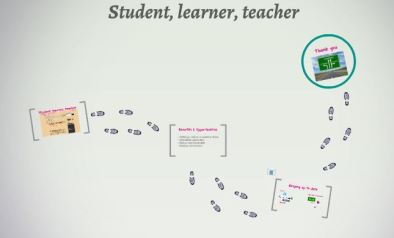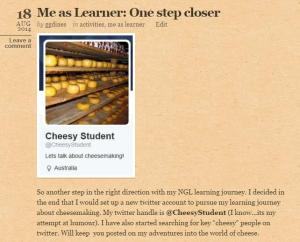
View this Prezi at: http://prezi.com/oimsretawbjz/learner-teacher/#
I was recently asked to talk to fellow staff at USC on the topic of “Teachers as learners”. My approach was to consider this topic from the point of view of my participation in EDU 8117 (student, learner, teacher) and my current professional role. As I have discussed in Week 1 and Week 6, my professional role is to support and advance learning and teaching. Included above is a screenshot and link to my prezi.
My presentation focused on a number of themes:
Benefits and opportunities of thinking in terms of student, learner, teacher.
I discussed a number of the benefits and opportunities of wearing all three hats, but will be focusing on a couple of these here:
Walking a mile in students’ shoes:
In Week 3, I recognise the benefits of using some of the difficult experiences of NGL to allow me to “walk a mile”.
“It took me a while to get Diigo to work for me and do what I wanted to do. This is good. As someone that supports university staff, the more I understand and experience this, the better I will be “as teacher”. So experiencing this activity “as student” has great learning opportunities that will improve my practice, philosophy and approach “as teacher”.”
Going further, I believe that incorporating an NGL approach into practice can have similar transformative effects for academic staff. By experiencing learning from a student perspective, teachers (such as myself) can develop greater awareness of the challenges that current students face and transform their practices to overcome some of these challenges.
Making connections and blurring the boundaries or lines between students, learners and teachers
By taking a “student, learner, teacher” approach, there is a greater opportunity to blur the lines that can exist in formal academia around these roles. There is extensive discussion in the literature that supports a blurring of these lines and highlights the benefits of self directed learning, and students as co-creators of knowledge (McLouglin, 2008; Beetham and Sharpe, 2008).
Inherent in all of this is the recognition of the value of lifelong learning for educators and that there are many ways to learn and the various roles of student, learner and teacher all have valid contributions to make to our learning.
These themes sum up my approach to how I see NGL informing my approach as teacher into the future. By adopting this approach myself, I will be modelling practices which I believe will advance learning and teaching in my context. This ties in with my earlier posts around moving from knowing and doing NGL to being NGL. Being NGL will allow me to successfully model another facet of good practice in learning and teaching. Examples of practices I will be modelling include:
- Embedding NGL tools and practices into events and activities that academic staff participate in, with the hope that they will be exposed to new ideas or practices.
- Referring and using to NGL literature to inform practice when working with academic staff.
- Modelling use of web 2 tools. For example showing how I harness NGL and web 2 tools for managing the proliferation of information – as student, learner or teacher. (See Week 2)
Will this actually make a difference?
I think this is a perpetual question for all academic development units and the staff working in them. I am no different. I ask this question all the time. Being and modelling good practice is at the heart of my approach. The benefit of this is that it means I remain in touch and up to date with current developments and trends in the field. Acting as a change agent by unobtrusively practising good practice myself. A couple of strategies I employ in the hope that my work can make a difference:
- Don’t think too big. Small changes are more effective and achievable. They don’t overwhelm. Scaffolding is crucial.
- Making a direct connection between a change in practice and a desirable outcome: Happy students, time saving, keeping up to date and managing lifelong learning effectively, digital literacies that help them manage and navigate the digital world. Different staff are motivated by different “desirable outcomes” and the challenge is to get this right for each individual.
Progress is slow. Slow progress means a cost to the organisation. I will end with a quote from Week 8 that discusses some of the challenges I face as a “teacher” in my role and supports McIntyre’s (2014) argument that academic staff can contribute to disruptive innovation in their organisation by looking outward:
“As a teacher I need to learn how to harness NGL without alienating learners and this means catering to different requirements and preferences. It also means ensuring that academic staff don’t feel as though they must invest significant time before they get satisfaction. I think what Dede talks about in David’s favourite quote could be very useful here. Learners have different preferences and NGL isn’t for everyone – it is one way (amongst a number of ways) that learners are able to choose to learn. The upside of NGL in my context is the ability for academics to engage in their own time and at their own pace. Building on this positive, Simon McIntyre recently published an article that acknowledges that universities are the opposite of agile and that change takes time, even when the need for it is accepted. He suggests academics should be looking outward rather than inward for professional development and that systemic change can come from the bottom up through “disruptive innovaton”.”
References
Beetham, H., & Sharpe, R. (Eds.). (2008). Rethinking pedagogy for a digital age: Designing and delivering e-learning. Oxon, UK: Routledge.
Dede, C. (2008). Theoretical perspectives influencing the use of information technology in teaching and learning. In J. Voogt & G. Knezek (Eds.), International Handbook of Information Technology in Primary and Secondary Education (pp. 43–62). New York: Springer.
McIntyre, S. (2014). Reducing the digital literacy divide through disruptive innovation. HERDSA Review of Higher Education, 1.
McLoughlin, C., & Lee, M. J. (2008). Mapping the digital terrain: New media and social software as catalysts for pedagogical change. Paper presented at the Ascilite Melbourne, Melbourne.

